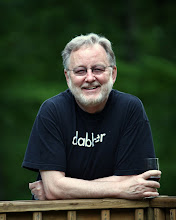Saturday, April 02, 2005
Gmail is getting better and more powerful
Email is a part of almost everybody's daily life nowadays, I suppose. And since Google came along (that link recounts a short history of Google's growth and development), it has become everyone's favorite little "search engine that could." So when Google decided to create an email client, called Gmail that offered 1 GB of storage, many in the technology world and elsewhere sat up and took notice.
Although it is still in beta, thousands of people have Gmail accounts, which at this point still must be obtained by someone's sending you an invitation. For a while, these invitations were in such demand that they were being bought and sold on Ebay. Fortunately they are now much more readily available from those who have Gmail accounts. In fact, I have about 150 available to distribute. You can email me if you'd like to receive one. (By the way, that email link is to a Gmail account I've created exclusively for use with this blog. It is "talktoperry" at "Gmail" dot "com" and you are welcome to use it to make comments on anything I've posted here.)
Yesterday, on Gmail's first anniversary, the folks at Google "kicked it up a notch" to borrow from Emeril Lagasse's favorite phrase. They announced a host of new features. Perhaps the most notable of these new features is that they doubled the amount of storage they are offering users, and they indicated that they will continue increasing that storage as their capacity permits.
Yet it is not just the vast storage capacity they provide that makes Gmail so appealing. They have designed the system very nicely. For instance, see this screenshot of what the Inbox on Gmail looks like. Take time to examine the labels on the various features. In particular I like the use of the concept of "labels" in Gmail because it is a much better paradigm than putting messages into folders to organize them. One reason is that in most email programs you must either keep multiple copies of an email in one or more folders if it contains information about more than one thing, and that takes up space on your computer, or you must settle for one "appropriate" folder for it. With Gmail you can add multiple labels so that it is categorized in several different ways. So labels are a very powerful feature of Gmail's design. This picture of what Gmail calls a "conversation" shows the original message and all the replies to it. And this search dialog enables you to use the power of Google to search through all the mail you've gotten for that particular message that you know you received, containing the recipe for Grandma's apple pie, but that you can't find because you didn't have the forethought to file it in a way that you can remember.
Still some people are skeptical and frightened by the power of Google's email service. For instance, see this link or this one. Everyone should judge for himself and decide how he or she feels about the issues raised by these skeptics.
As for me, I've concluded that the dye is already cast once anyone decides to connect to the WWW. If you don't wish to leave a trail that can be followed by sophisticated researchers, then you must do all your business in cash, sleep in a different place every night (ala Saddam Hussein), always wear a disguise when you go out on the street because you are constantly being photographed by various store and traffic cameras, and otherwise live in a paranoid, reclusive way that hardly permits contact with other people. The only truly safe computer is the one that is connected to nothing else. But as Grace Murray Hopper said, "A ship in port is safe, but that's not what ships are built for." And computers perform best and most productively when they are connected to other computers and to networks.
Since I'm not yet willing to become a hermit, I'm not going to bother with such deceptions, and instead I plan to remain connected. Gmail and Google make being connected easier and more rewarding, and frankly, more fun.


